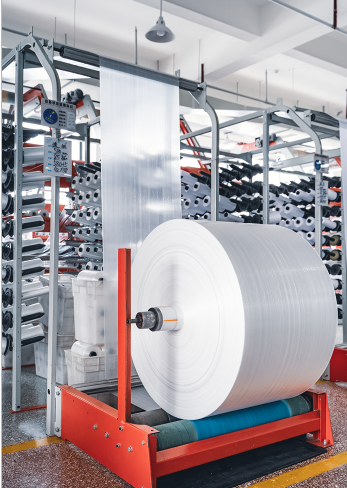
To manufacture cement bags, polypropylene granules are melted and extruded into thin threads, which are woven into fabric, laminated for strength and moisture resistance, and then cut, printed, and stitched into bags. This process ensures the bags are durable, lightweight, and capable of protecting cement during transport and storage.
The primary raw material for cement bags is polypropylene (PP) plastic, a strong and durable material. Polypropylene is preferred because it is lightweight, tear-resistant, and water-resistant, making it ideal for protecting cement during storage and transport. In some cases, laminated polyethylene layers are added to enhance moisture resistance.
The production starts with melting polypropylene granules. These are extruded into thin strips, cooled, and stretched to create high-strength yarn. The yarn is wound onto rolls for uniformity and durability, ensuring it meets the needs of cement bags.
Polypropylene yarn is fed into high-speed circular looms to produce woven sheets. This step forms the structural base of the cement bags, ensuring they can handle heavy weights and rough handling during storage and transport.
To make the fabric stronger and moisture-resistant, woven polypropylene sheets are laminated with polyethylene. This layer protects the material from environmental factors, making it ideal for bags for cement used in bulk packaging.
The laminated fabric is printed with logos, handling instructions, and regulatory information using advanced flexographic or gravure printing. These methods ensure clear and long-lasting prints, adding market value to each cement plastic bag.
The printed fabric is cut into specific sizes for the desired bag dimensions. Automated sewing machines stitch the edges securely. Additional features like gussets, handles, or valve openings can be added to customize the cement bags for specific purposes.
Each bag undergoes strict quality checks to ensure it meets industry standards. Tests include tear resistance, weight capacity, and moisture protection. Only bags that pass all tests are approved for packaging and shipment, ensuring reliability for every cement bag manufacturer and customer.
The manufacturing of cement bags is a process that involves precision, advanced technology, and strict quality control. From selecting the right materials to the final inspections, each step is crucial to ensure the bags perform their function effectively. Xifa provides durable and high-quality cement bags crafted with precision and care. Explore our collection to find reliable solutions for your packaging needs. Whether you need bulk bags for cement or custom options, Xifa has you covered. Visit our website to learn more!




